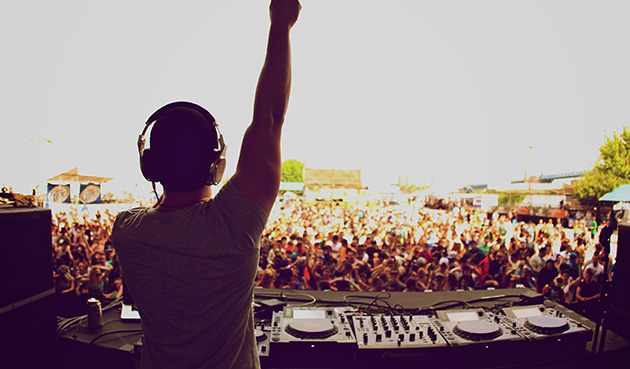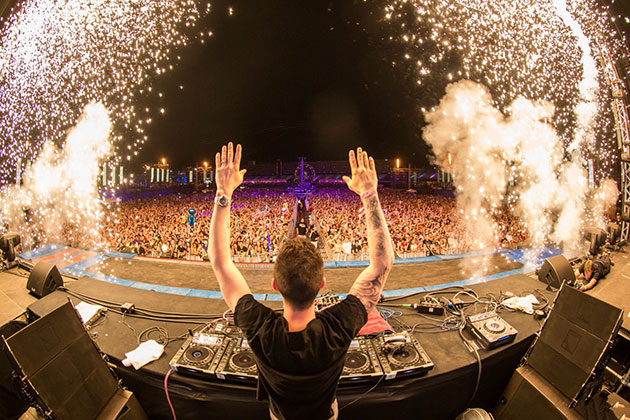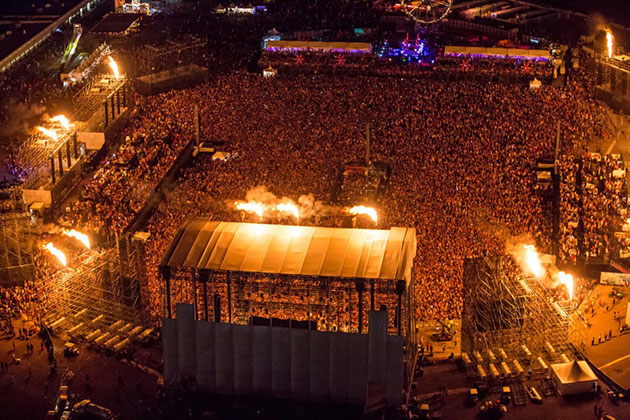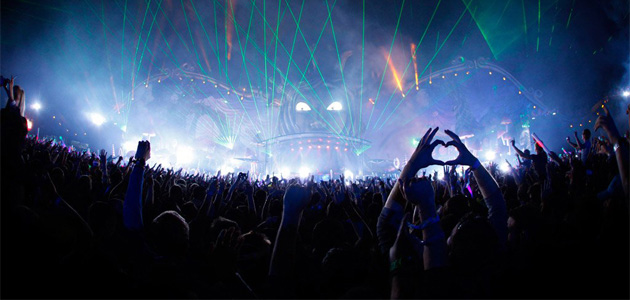 No matter if Ultra, Electric Daisy, Electric Zoo, or Creamfields is your event of choice, the notion of “If you’ve seen one, you’ve seen them all” applies to practically all large-scale electronic dance music events on either coast and likely any continent. If you’ve gone to any of these, or even some of the small-scale nights at Miami Music Week, the same format prevails from producer to producer: 45 to 60 minutes on stage, with close to 75 percent of all tracks recognizable by the crowd and a few bass drops and synth crescendos to add some structure.
No matter if Ultra, Electric Daisy, Electric Zoo, or Creamfields is your event of choice, the notion of “If you’ve seen one, you’ve seen them all” applies to practically all large-scale electronic dance music events on either coast and likely any continent. If you’ve gone to any of these, or even some of the small-scale nights at Miami Music Week, the same format prevails from producer to producer: 45 to 60 minutes on stage, with close to 75 percent of all tracks recognizable by the crowd and a few bass drops and synth crescendos to add some structure.
From a marketing perspective, electronic dance music events in U.S. and Europe are huge money-makers: for Electric Daisy Carnival’s three-day 2012 festival in Las Vegas, 320,000 people attended, with $207 million going toward the local economy. This excludes any amounts coming from Las Vegas’ clubs like Marquee attracting big-name DJ talent throughout the year. EDM’s global domination over the past decade similarly influenced the Netherland’s economy, which, considering the amount of house and trance talent coming out of the small European country, is all but inevitable.
When you consider large-scale EDM events in this context, then, restrictions envelope each performer and promoter: the expectation to create a product that brings in money, the need to draw larger and larger crowds, and a formula that keeps crowds with high purchasing power and social media influence interested and buying tickets at $300-plus a pop. Such factors make Avicii’s decision to bring live country musicians out on stage at Ultra 2013 a big deal: Regardless of whether you consider “Wake Me Up” a total crock of novelty garbage or the next thing in electronic dance music, it takes some serious balls to pause to start up a few country-house tracks when promoters and the audience are waiting for some bass drops and four-to-the-floor beats.
Whether Avicii realizes it or not, his move was kind of a thumb-on-the-nose reaction to everything mainstream EDM – and it seriously perturbed not only the crowd, who seemed at least shocked during the show, but also his contemporaries. Whether the 23-year-old house producer prodigy is getting seriously sick of 300 gigs a year when he could be spending time in the studio putting together another hit like “Levels,” rather than half-baked tracks like “Avicii x You” and “I Could Be The One,” the Los Angeles Times published a write-up of Electric Daisy Carnival last week that reflects the same, possibly indirect, stance: That setlists don’t change between big events and that concert promoters and large venues are partially to blame.

“But if we’re going to treat DJs like rock stars, dance festivals have to deliver something singular and essential every time, if only to prove that this rich strain of music doesn’t all sound the same,” August Brown wrote in the review, and we agree. Save for underground events, Movement, and shows headlined by one or two DJs, some serious changes need to be made to the modern EDM festival.
Change Who’s on the Main Stage
Without a doubt, EDM festivals from East to West Coast stick with practically all the same headliners, or the big money-maker talent: Tiesto, Skrillex, Avicii, Afrojack, Calvin Harris, David Guetta, Swedish House Mafia, Deadmau5 (if he’s on the bill), Zedd, and, depending if a separate trance tent is set up, Armin Van Buuren. Maybe you’ll see an appearance from Laidback Luke, Bingo Players, Hardwell, Nervo, Sander Van Doorn, Fedde Le Grand, or the latest “young” or “hot up and comer” talent like Madeon, Tommy Trash, Alesso, Cazzette, or Nicky Romero. The problem with this set up is, while it’s perfect for marketing, the same performers coupled with the same setlists they did the night before results in a foundation that remains unchanged.
While for the dollars to come in, this predictability is needed, it gets really, really dull after a while, and if you’re looking for “good” music, you almost always stay away from the main stage. Whether this means taking a jaunt over to Carl Cox’s multi-day setup at Ultra or stopping by Skrillex’s OWSLA tent, the concertgoer becomes responsible for creating this variety.
YourEDM.com drew attention to this in an editorial this week, stating: “Unfortunately, as many other electronic fans can attest, this is a downward spiral that has been going on for quite some time. Too many DJs take the decks hoping to please the crowd, instead of displaying their own musical personality.”

If the EDM festival main stage could be a personality, it’s the always-on extrovert: Great to be around for the energy, but draining and pedantic not long after. After a while, it makes you say, “Show some mistakes! Show me something different! Drop the blatant phoniness!” and want the more “introverted” aspects of techno and post-dubstep to surface.
If the main stage weren’t the center of a marketing strategy (after all, why else does Ultra Music Festival only reveal its more obscure performers in the last lineup announcement?), EDM festivals might want to mix up who appears: a bit of progressive house, a hint of dubstep and trap, some trance to cool things down, and some “live” dance music like synthpop could mirror the perfect multi-hour long DJ set, rather than the producers themselves tossing in mixes of the year’s top Beatport tracks.
Add Variety to the Setlists
If a festival’s main stage and even notable side tents were one six-hour long DJ playlist, it would contain the same four tracks played at two-hour intervals – each one slightly different from the last but still noticeable through an intact vocal line or synth part. What happens, if you’re a cognizant audience member, is a sort of déjà vu – only, you’re listening closely to hear what the DJ did differently this time around. Was the bass harder, the pitch up a half-tone? The vocals more stripped down, distorted, or buried in a mix? When listeners have to play spot-the-differences between each setlist, you know EDM festivals have reached a low point in terms of laziness and a lack of creativity for bringing in the dollars.
Back when we went to All Mixed Up in New York City, this proved to be an issue even with only four performers in the lineup. Save for “traditional” DJ Carl Kennedy, Sebastian Ingrosso’s two protégés Otto Knows and Alesso trotted out a handful of the same tracks that the Swedish House Mafia producer and label manager likely had a hand in, including collaboration “Calling.” Of course, by the time Ingrosso took the stage, this made his closing set look tired and like old news. When you check your cell phone for the time during a two-hour set, you know the DJ has to work harder.
If such track overlapping can happen at a four-producer event, consider it greatly magnified on the main stage of a festival and even larger once setlists from all tents are taken into account. It’s that bad top 40 radio effect – a track that sounds good with a first listen turns into a vexing annoyance the fifth time around.
While some speak of DJs’ artistry, intricacies, and skills and others may call it “button pushing,” producers behind a controller or laptop can still “press buttons” and end up with different setlists with just a bit of planning ahead. Reiterated tracks throughout a night just smacks of pure laziness.
Less Emphasis on the Visuals
Along electronic music’s varied history, someone must have first said, “I know what’ll make this music more interesting – a bunch of bright lights and seizure-inducing visuals.” Whether you can blame it on the Pet Shop Boys, who apparently didn’t tour because their singer-keyboardist setup seemed too dull until some backup dancers were added, or attribute it to the fading days of electronica and emerging trance in the late 1990s, with Tiesto needing to fill stadiums, some individual decided along the way that audiences can’t enjoy synthesizers until a visual element is added.

This has resulted in Daft Punk’s pyramid – and has also given acts like Swedish House Mafia and David Guetta to get lazy with pre-programmed setlists and “forget” using headphones all for the sake of synching up audio and visuals.
While VJing itself has turned into its own art form, conversation about events like Electric Daisy Carnival shifts over to the visual elements, even to the point that the music starts to seem secondary. Tying into the notion that visuals must be lined up with tracks, the less bright, flashing lights seem like a necessity, the fewer restrictions DJs have regarding creativity.
We’ve named only three major qualms with big EDM festivals. Which other aspects do you think should be changed, added, or thrown out completely?




